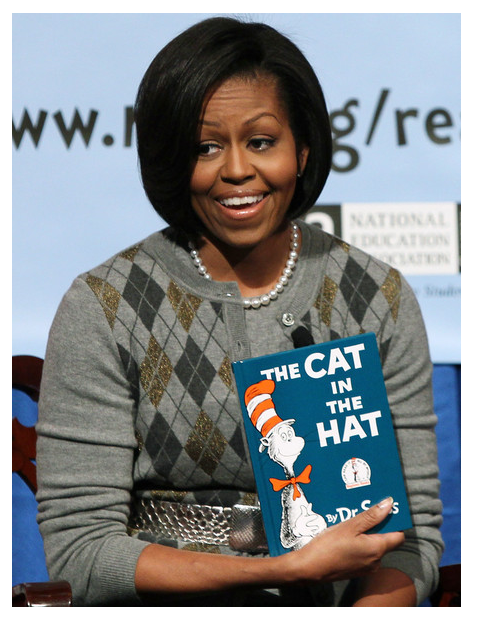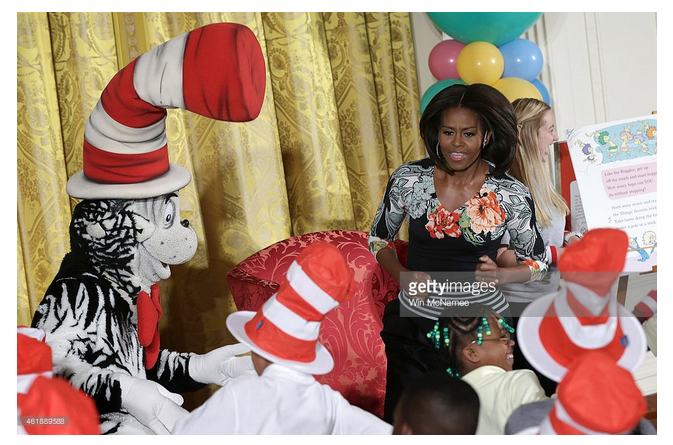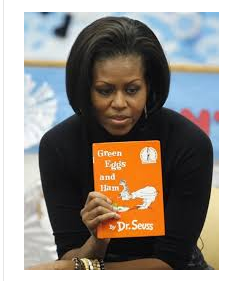Yesterday The Howie Carr Show (a talk show out of Boston) posted an article about a librarian in Cambridge, Massachusetts. To celebrate National Read A Book Day, Melania Trump sent ten Dr. Seuss books to a Cambridge public school.
This is the letter she received from the librarian:
Dear Mrs. Trump,
Thank you for the ten Dr. Seuss titles that you sent my school library in recognition of this year’s National Read a Book Day. (Sent second-day air, no less! That must have been expensive.) I’m proud that you recognized my school as something special. It truly is. Our beautiful and diverse student body is made up of children from all over the world; from different socioeconomic statuses; with a spectrum of gender expressions and identities; with a range of abilities; and of varied racial, ethnic, and religious backgrounds.
According to the White House website, you selected one school per state by “working with the Department of Education to identify schools with programs that have achieved high standards of excellence, recognized by State and National awards and Blue Ribbon Awards…” Each of those carefully vetted schools received ten books: Seuss-isms!; Because a Little Bug Went KaChoo; What Pet Should I Get?; The Cat in the Hat; I Can Read with My Eyes Shut!; One Fish, Two Fish, Red Fish, Blue Fish; The Foot Book; Wacky Wednesday; Green Eggs and Ham; and Oh, the Places You’ll Go!.
My students were interested in reading your enclosed letter and impressed with the beautiful bookplates with your name and the indelible White House stamp, however, we will not be keeping the titles for our collection. I’d like to respectfully offer my explanation.
* * * * *
My school and my library are indeed award-winning. I work in a district that has plenty of resources, which contributes directly to “excellence.” Cambridge, Massachusetts, is an amazing city with robust social programming, a responsive city government, free all-day kindergarten, and well-paid teachers (relatively speaking — many of us can’t afford to live in the city in which we teach). My students have access to a school library with over nine thousand volumes and a librarian with a graduate degree in library science. Multiple studies show that schools with professionally staffed libraries improve student performance. The American Association of School Librarians has a great infographic on these findings. Many schools around the state and country can’t compete.
Yearly per-pupil spending in Cambridge is well over $20,000; our city’s values are such that given a HUGE range in the socioeconomic status of our residents, we believe that each and every child deserves the best free education possible and are working hard to make that a reality (most classrooms maintain a 60/40 split between free/reduced lunch and paid lunch). This offers our Title I school and the district a lot of privilege and room for programming and pedagogy to foster “high standards of excellence.” Even so, we still struggle to close the achievement gap, retain teachers of color, and dismantle the systemic white supremacy in our institution. But hell, we test well! And in the end, it appears that data — and not children — are what matters.
Meanwhile, school libraries around the country are being shuttered. Cities like Philadelphia, Chicago, and Detroit are suffering through expansion, privatization, and school “choice” with no interest in outcomes of children, their families, their teachers, and their schools. Are those kids any less deserving of books simply because of circumstances beyond their control? Why not go out of your way to gift books to underfunded and underprivileged communities that continue to be marginalized and maligned by policies put in place by Secretary of Education Betsy DeVos? Why not reflect on those “high standards of excellence” beyond only what the numbers suggest? Secretary DeVos would do well to scaffold and lift schools instead of punishing them with closures and slashed budgets.
* * * * *
So, my school doesn’t have a NEED for these books. And then there’s the matter of the books themselves. You may not be aware of this, but Dr. Seuss is a bit of a cliché, a tired and worn ambassador for children’s literature. As First Lady of the United States, you have an incredible platform with world-class resources at your fingertips. Just down the street you have access to a phenomenal children’s librarian: Dr. Carla Hayden, the current Librarian of Congress. I have no doubt Dr. Hayden would have given you some stellar recommendations.
Another fact that many people are unaware of is that Dr. Seuss’s illustrations are steeped in racist propaganda, caricatures, and harmful stereotypes. Open one of his books (If I Ran a Zoo or And to Think That I Saw It On Mulberry Street, for example), and you’ll see the racist mockery in his art. Grace Hwang Lynch’s School Library Journal article, “Is the Cat in the Hat Racist? Read Across America Shifts Away from Dr. Seuss and Toward Diverse Books,” reports on Katie Ishizuka’s work analyzing the minstrel characteristics and trope nature of Seuss’s characters. Scholar Philip Nel’s new book, Was the Cat in the Hat Black? The Hidden Racism of Children’s Literature, and the Need for Diverse Books, further explores and shines a spotlight on the systemic racism and oppression in education and literature.
I am honored that you recognized my students and our school. I can think of no better gift for children than books; it was a wonderful gesture, if one that could have been better thought out. Books can be a powerful way to learn about and experience the world around us; they help build empathy and understanding. In return, I’m attaching a list of ten books (it’s the librarian in me) that I hope will offer you a window into the lives of the many children affected by the policies of your husband’s administration. You and your husband have a direct impact on these children’s lives. Please make time to learn about and value them. I hope you share these books with your family and with kids around the country. And I encourage you to reach out to your local librarian for more recommendations.
Warmly,
Liz Phipps Soeiro
School Librarian
Cambridge, MA
Interesting. Particularly when you consider the following:


 The double standard here is amazing. First of all, Dr. Seuss was not a racist. His actual name was Theodor Seuss Geisel.
The double standard here is amazing. First of all, Dr. Seuss was not a racist. His actual name was Theodor Seuss Geisel.
The is an excerpt from his biography at Wikipedia:
Geisel was born and raised in Springfield, Massachusetts, the son of Henrietta (née Seuss) and Theodor Robert Geisel.[5][6] All four of his grandparents were German immigrants.[7] His father managed the family brewery and was later appointed to supervise Springfield’s public park system by Mayor John A. Denison[8] after the brewery closed because of Prohibition.[9] Mulberry Street in Springfield, made famous in Dr. Seuss’ first children’s book And to Think That I Saw It on Mulberry Street, is less than a mile southwest of his boyhood home on Fairfield Street. Geisel was raised a Lutheran.[10] He enrolled at Springfield Central High School in 1917 and graduated in 1921. He took an art class as a freshman and later became manager of the school soccer team.[11]
Geisel attended Dartmouth College, graduating in 1925.[12] At Dartmouth, he joined the Sigma Phi Epsilon fraternity[5] and the humor magazine Dartmouth Jack-O-Lantern, eventually rising to the rank of editor-in-chief.[5] While at Dartmouth, he was caught drinking gin with nine friends in his room.[13] At the time, the possession and consumption of alcohol was illegal under Prohibition laws, which remained in place between 1920 and 1933. As a result of this infraction, Dean Craven Laycock insisted that Geisel resign from all extracurricular activities, including the college humor magazine.[14] To continue work on the Jack-O-Lantern without the administration’s knowledge, Geisel began signing his work with the pen name “Seuss”. He was encouraged in his writing by professor of rhetoric W. Benfield Pressey, whom he described as his “big inspiration for writing” at Dartmouth.[15]
Upon graduating from Dartmouth, he entered Lincoln College, Oxford intending to earn a PhD in English literature.[16] At Oxford, he met Helen Palmer, who encouraged him to give up becoming an English teacher in favor of pursuing drawing as a career.[16]
The actual footnotes can be found at Wikipedia.
There is no way that Dr. Seuss was a racist. This is an example of how trite the charge of ‘racism’ has become. America has not solved the problem of racism, but we have made strides in the right direction. We need to encourage strong families and good education in the black communities in America. However, to label things and people that are not related to race as racist does not help the cause of racial equality in America. Trump derangement syndrome has taken over the media and much of our educational system. It is time to get back to working together to improve our country–not trying to tear it down.



